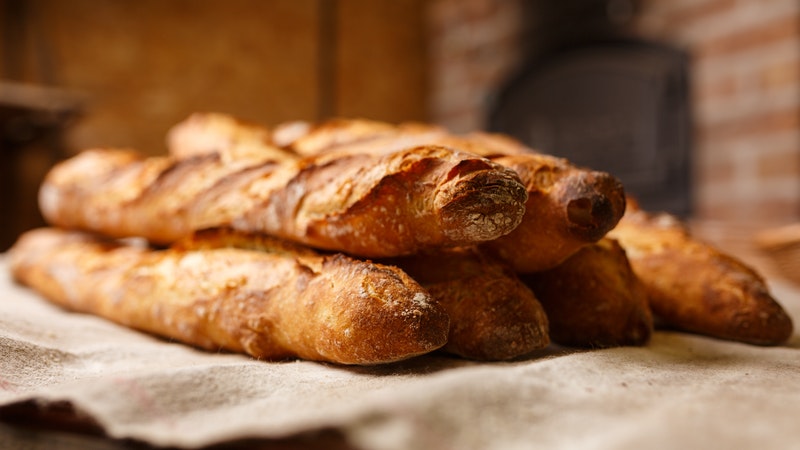Baguette
Episode #5 of the course Introduction to bread making by Alice Morgan
Greetings! Today, we’re going to move on to a new country, France, and discuss baguettes.
History
Baguettes are a long, thin bread with a crunchy crust and soft insides from France. Although the word “baguette” wasn’t used until the 1920s to describe this style of bread, its ancestor has been around for much longer, with evidence of similarly shaped bread being produced since the 17th century.
Despite its age, there is some disagreement as to exactly when and where baguettes as we know them began to be produced. Some people believe the bread was linked to the French Revolution, when baking ingredients were unregulated and the poor frequently ate bread that contained sawdust or even dirt. After the Revolution, bread could only be made of wheat and rye, with a fixed price for loaves by weight.
Another common story is that Napoleon Bonaparte himself was responsible for the beginning of baguettes when he purportedly mandated that loaves be baked to fit into a pocket on his soldiers’ uniforms.
Whatever the origin, baguettes hit their heyday in the 1920s when a new law mandated that French bakers could not start their work before 4:00 am. Since baguettes were much faster to make than other forms of bread, bakers began to make them in order to have freshly baked bread on hand in time for breakfast. The baguette has also shortened to the length that we’re used to seeing today. In the past, they could be as long as 6 feet (1.8m)!
With their history in mind, it’s safe to say that baguettes are a popular bread choice today. Some estimates say that France produces as many as ten billion baguettes a year, which is enough to feed one of its citizens 150 loaves a year.
Recipe: French Baguettes (Makes 3 Loaves)
4 cups (480g) bread flour
1 tablespoon (15g) yeast
1 tablespoon (15g) salt
1½ cup (360ml) warm water
1 teaspoon (6ml) honey
Add the yeast, honey, and warm water in a large bowl. Let the mixture sit in a warm spot for about ten minutes until the yeast becomes foamy. Add flour and salt to the liquid. Turn out and knead the dough on a floured surface, adding more flour if needed, until the dough is smooth and elastic when gently tugged. Divide the dough into three pieces, and roll each piece into a even stick-shaped loaf. Place the leaves on an oiled baking sheet, cover with a damp cloth, and let rise for an hour.
Once the dough has risen, use a very sharp knife to score four evenly spaced diagonal lines on the top of each loaf. Preheat the oven to 450°F (230°C), and place a second pan with a little water on the bottom rack of the oven just before the bread goes into the oven. The steam for the water is crucial for the baguette’s final texture. Put the risen, scored loaves into the oven on the top rack, and allow them to cook for about 15 minutes until they are golden brown and slightly shiny.
Cooking tips:
• For extra crunch, shut off the heat and allow the bread to cool inside the oven.
• If you’re having trouble with the pan of water, you can try ice cubes instead for an easier and more regulated steam bath.
• Make sure the knife you use to score the bread is razor sharp. If you don’t have access to a sharp knife, you can try snipping the dough with scissors for a similar result.
That’s the end of today’s lesson. I hope you’re able to impress your next dinner guests with some crunchy, savory baguettes. Tomorrow, we’ll cover naan. See you then!
Recommended reading
How Napoleon Armed His Soldiers with Baguettes
Recommended book
Share with friends

